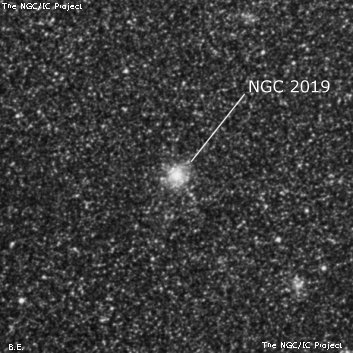
S-L 542 (brightest of 3 nearby clusters) is 4.6' SW, BSDL 2196 is 2.7' SW and S-L 544 is 5' NNW. S-L 542 is fairly bright, moderately large, round, 40" diameter, mottled but with no definite resolution. A mag 12.8 star is 0.9' NW. BSDL 2196 (noticed between NGC 2019 and S-L 542) is a very faint, small, round, low surface brightness patch, 20" diameter, no resolution.
John Herschel discovered NGC 2019 = h2905 on 11 Nov 1836 and recorded the cluster as "B; R; gbM; 60". He observed it on two sweeps and his position is just off the east side. On the first observation, though, his polar distance was 1° further north, but he rejected that (correctly) in favor of the polar distance in the second sweep.
James Dunlop possibly discovered NGC 2019 = D 96, D 98, D 99 and/or D 94 (one or more of these may apply!) on 24 Sep 1826 with his 9" reflector from Parramatta. He described D 96 as "a faint round nebula, about 1 1/4' diameter, slightly bright to the centre." Dunlop made two observations of D 96 and his position is 12' NW of this cluster. But his position is also 12.6' SE of NGC 1986, so this description could also apply to the later cluster. D 98, described as "a pretty well-defined round nebula, about 30" diameter" was observed twice and the position is just 1.9' W. Finally, D 94, described as an "extremely faint small nebula" is also within Dunlop's usual errors (7' S of the cluster). To further confuse the issue, Glen Cozens identifies NGC 2019 = D 99, which Dunlop described as a "pretty well-defined nebula, 20" diameter." His position in this case is 16' SE of the cluster!
600/800mm - 30" (10/14/15 - OzSky): at 394x; extremely bright, large, 50" diameter, sharply concentrated with a large intense core and smooth halo, no resolution. NGC 2019 is one of 15 bona-fide ancient GC's in the LMC.
Notes by Steve Gottlieb